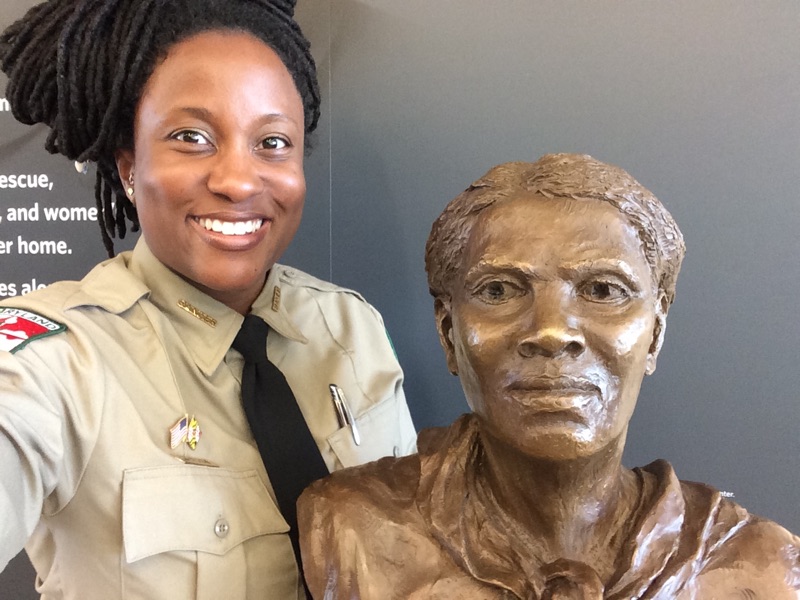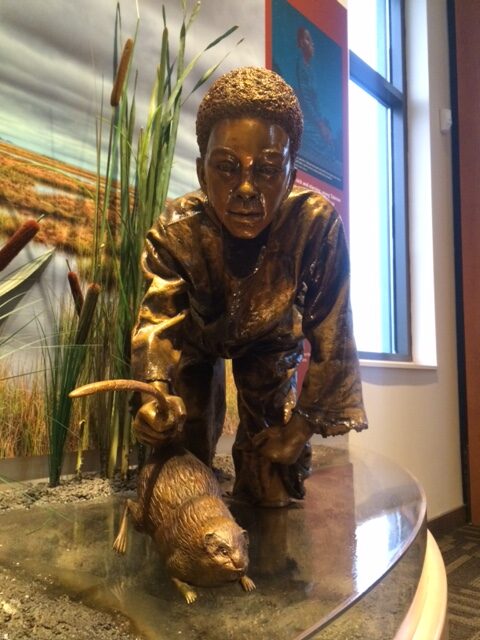by Pat McShea

“Is that owl real?” Students who approached the museum activity station at a “Dream STEAM” event on Martin Luther King Jr. Day repeated those four words to express curiosity about a 20-inch-high Barred Owl taxidermy mount. The setting was a large meeting room in the Bible Center Church’s Worship, Arts, Recreation, and Ministry Center in Pittsburgh’s Homewood neighborhood. Here, during a busy three-hour morning session, small groups of students ranging from kindergarten to fifth grade rotated with their adult chaperones among activities related to STEAM (Science, Technology, Engineering, Art, and Math) or Black History and Culture.
I was one of three museum representatives who brought the owl and other, less visually striking materials, to enhance an activity we hoped would spark greater interest in science as well as increase knowledge about a heroic Black figure in American History, Harriet Tubman.
Answers of “partially real” to student questions about the owl’s authenticity were provided first, as we shared information about the taxidermy mount’s glass eyes, wire-supported feet, interior foam body, but very real feathers, beak, and talons. Then came an explanation about how in 1849, Harriet Tubman’s expert knowledge of tides, seasons, weather, wildlife, plants, and the stars of the night sky enabled her to escape enslavement on a timber plantation on the Eastern Shore of Maryland, and then safely cross more than 100 miles of forest and wetlands to reach freedom in Philadelphia, Pennsylvania.
Tubman returned to Maryland multiple times during the next ten years to safely lead a total of approximately seventy people in escape from enslavement to freedom, which could sometimes only be guaranteed in places as distant as Canada. When we recounted these courageous actions for the students, the owl assumed a prominent role in our narrative. Tubman used imitations of Barred Owl calls as a code of cautionary signals to the people she physically guided. With the aid of a battery powered bird song player, the students were able to listen to the species’ distinctive barked notes, nine booming syllables that invite translation into the echoing question, “Who Cooks For You? Who Cooks For You All?”
Imitation owl calls from the students followed, spontaneous and solicited, with both types gently critiqued by a reminder that in the dark woods of 1850’s coastal Maryland or Delaware, the skill of the call’s delivery could be a matter of life or death.
The museum’s activity station also provided opportunities for students to note owl adaptations via pencil drawings, and to examine muskrat pelts as an aid in considering Harriet Tubman’s childhood labor checking traps for the rodents in the marshes of the plantation where she was enslaved. One tabletop display that drew the attention of some students and every adult chaperone credited Ranger Angela Crenshaw, currently Park Manager for Rocks, Susquehanna and Palmer State Parks in Maryland, as the source for much of the activity’s shared information.

A West Virginia native with strong Baltimore roots, Crenshaw presented interpretive programs for over four years as a ranger at Harriet Tubman Underground Railroad State Park and Visitor Center, a 17-arcre site in Dorchester County, Maryland. Last year, the bicentennial anniversary of Tubman’s birth, articles about the historic icon’s naturalist skills in both Audubon and Smithsonian magazines included quotes from Crenshaw. On May 14, a date Pittsburgh Mayor Ed Gainey proclaimed as “Harriet Tubman Day” in the city, Crenshaw joined seven other presenters for a two-hour panel discussion on Zoom about Tubman’s legacy organized by the Dr. Edna B. McKenzie Branch of the Association for the Study of African American Life and History.

When a presenter from another organization asked about how Ranger Crenshaw became a reliable source for information about Harriet Tubman, I recalled a published interview during which she described how her earliest days at the then new park forced a deep immersion into the landscape, and lots of reading about American Slavery, the religion of enslaved people, and the Underground Railroad. Among those documents was an 1868 biography of Tubman titled The Moses Of Her People, by Sarah Bradford, and a letter endorsing the book, by another native of Maryland’s Eastern Shore who escaped enslavement, Frederick Douglass.
Related Content
King’s Dream and Natural History
Feather and Bone Connections to American History
Carnegie Museum of Natural History Blog Citation Information
Blog author: McShea, PatrickPublication date: February 6, 2023
